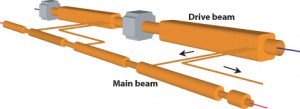The Compact Linear Collider (CLIC) is designed to bring electrons and positrons into collision at 3 TeV within just 50 kilometres. To reach that collision energy, a typical accelerator design would be anything but compact– easily spanning more than one hundred kilometres. “You would need tens of thousands of klystrons,” says CERN scientist Steffen Doebert.
Instead, the CLIC design makes use of an innovative two-beam solution. In addition to the main beam of particles used for studying collisions, CLIC will have a second stream of particles called the drive beam. The drive beam will serve as a power source, propelling the main beams to 1.5 TeV each for a 3 TeV collision.
To do this, the drive beam runs parallel to the main beam but travels in different directions—starting at the centre and moving outwards, where it will be distributed and turned around in 24 sectors such that the drive beam bunches will coincide with the incoming travel of particles along the main beam. The drive beam meanwhile, which runs at 2.4 GeV, requires 1,600 klystrons to accelerate. The drive beam will provide short pulses of high radiofrequency peak power. When drive and main beam bunches coincide, a special structure will decelerate the drive beam, gathering energy and transferring it to the main beam. This approach is also very efficient, carrying radiofrequency power in the drive beam with more than 95 percent efficiency.


Recent Comments